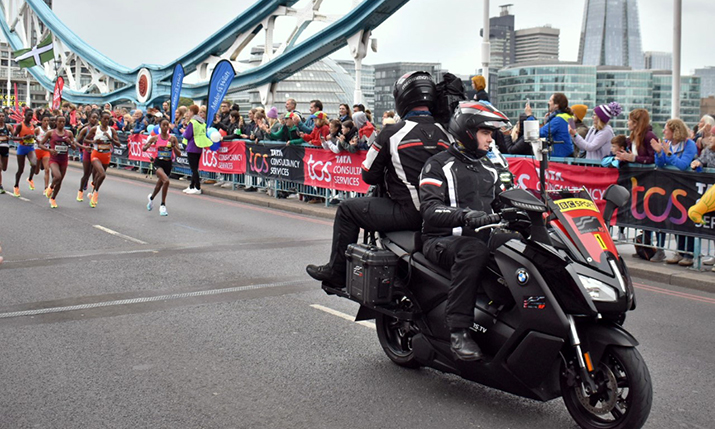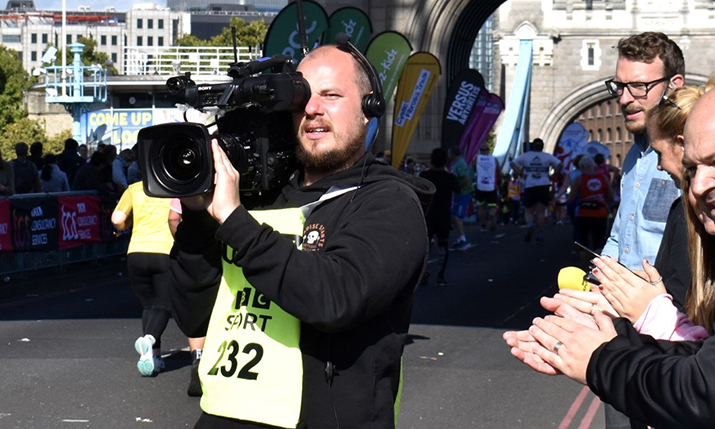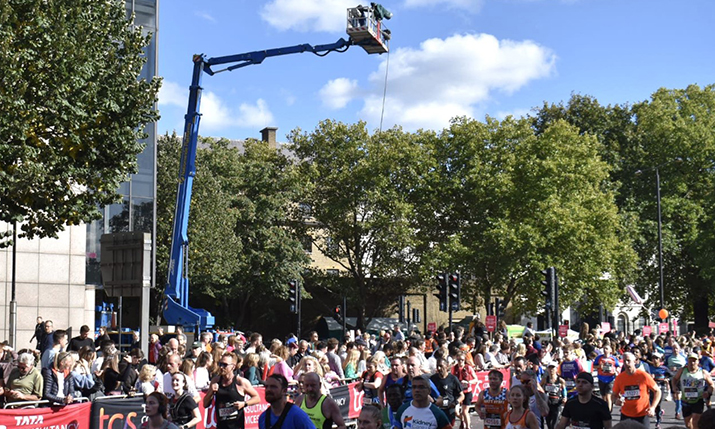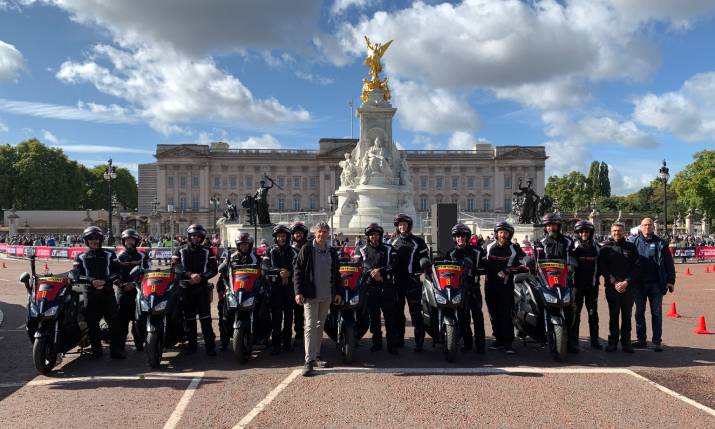Springtime in London: EMG on bringing the London Marathon 2023 home for the BBC

One of the EMG-supplied electric motorbikes filming Elite women runners on Tower Bridge at the London Marathon 2022
Finally back to its springtime slot after three years of being raced in the autumn, the 2023 London Marathon is to be the 43rd running of the annual event.
Taking place on 23 April, fans at home are ready to watch the full array of humanity sweating across the 26.219 miles of the course, from the Elites that will include British distance running stars Sir Mo Farah and Eilish McColgan, to the heavily costumed runners making thousands of pounds for charities.
EMG is all set to bring those pictures to people at home who will be glued to BBC One for full live coverage on the day. The technical services provider’s OB fleet for the race are based at Blackheath, Cutty Sark, Limehouse, Blackfriars, and Canada Gate at the end of the race. Most of the OBs include presentation and RF except at Blackheath, where there is no RF other than from the bikes that come in from Blackheath.
Long range plans
On the long range cameras being used for the London Marathon, Chris Brandrick, UK and group commercial director for EMG Connectivity says there will be two live camera helicopters covering the entire course for the Elite races. The aerial coordination and equipment supply is courtesy of Aerial Camera Systems (ACS).
He notes: “The helicopters will be AS355 twin engine helicopters, fitted with a gyro stabilised aerial camera system. RF equipment is fitted to the aircraft to either transmit up to the plane or down to the OB (once the relay aircraft has completed its mission). The helicopters will be relocated to deploy on the morning of the race to avoid heavy weather, which is common to early starts on the South Downs.”
There will also be six live electric camera bikes that are covering the entire course for the Elite races. Each bike is installed with EMG’s Livetools RF equipment. In the past two London Marathon events EMG Connectivity has seen significant improvements in its connectivity for coverage by deploying Livetools equipment for the long range RF camera sources.
Livetools is a manufacturer of RF technology exclusive to EMG. The technology was designed for long range RF applications where robustness is very demanding, and has been used on events such as the Tour de France, Giro d’Italia, and many other international sports events.
The Livetools Fusion transmitters and receivers are equipped with the XPRO modulation which is the most robust COFDM modulation of them all, according to Brandrick. All the Livetools products are fully monitorable via IP networks and/or RF links through its control software. The equipment comes with built in GPS transceivers and camera control for Sony, Grass Valley GVG and Panasonic cameras.
Brandrick comments: “The Livetools switchers can seamlessly switch between out-of-time sources from aerial and ground terrestrial relays. This is something else completely unique to the Livetools equipment that EMG uses.
“An interesting feature on the equipment is the LAN bridge; we can establish a full IP broadband link from any of our sources, which means we can bring broadband comms to the bike pilots and camera operators, deploy RF monitors under the aircrafts footprint, or even a simple Teams or WhatsApp meeting with your colleagues anywhere on the course,” he adds.

BBC Sport worked with EMG to capture the 2022 London Marathon, and is looking forward to doing the same this year
Getting the signal home
Brandrick adds on the electric motorbikes being used to capture the excitement of the Elite races: “Our bikes are customised and have the ability to sit the camera operator forwards or backwards with special modifications for camera and RF operations. We have the ability to mount the transmit antenna behind the rear facing camera operators, providing them with a 180 degree unobstructed field of view.
“Power is taken from batteries mounted in the bike’s pannier. These independent batteries have the capability of powering the RF transmission system and camera for the duration of the event, without the need to draw any power from the bikes.
“Cameras are supplied with image stabilisers and the stabilised lenses we supply have a built-in optical image stabilization system that employs Canon’s patented Vari-Angle Prism Image Stabiliser (VAP-IS).
“All bikes have a GPS system for tracking and mapping,” he goes on. “This allows us to monitor the location of the bikes and facilitates the tracking antennas in the relay aircraft to follow the bikes ensuring the most effective RF camera coverage. Full duplex comms is supplied for bike pilots and camera operators with independent talkback between the two.”
“We’re ready for this year’s London Marathon; it’s going to be another great day come rain, hail or sun and we will deliver those pictures to the people at home, from the air and on the ground”
Additionally for the long range camera plan, there will be one B200 pressurised RF relay aircraft that will be relaying all video, data and comms signals, plus one RF reception site located at Canada Gate which will be feeding all mobile sources to the OB.
Broadcast RFs premium fixed wing aircraft partner is Aerosotravia, an operator that specialises in broadcast aerial work. The advantage of Aerosotravia is its fleet capacity and stand by service during operational aerial work.
All aircraft deployed are pressurised Beechcraft King Air types (E90 or B200). “Currently we can deploy six aircraft, all identical and equipped with tracking systems, meaning full backup is available if required,” notes Brandrick. “The endurance of these E90’s or B200’s airplanes is up to eight hours 30 minutes, ideal for the London Marathon. The normal operating level of the aircraft is between 23,000 feet to 31,000 feet. The relay aircraft is fitted with an array of GPS tracked receiving and transmitting antennas to suit all needs for long distance RF relaying.
“The bike receivers installed in the aircraft have four inputs and we supply splitters to allow patching of any combination of antennas into any receiver,” he continues. “Our multiplexed outputs allows all signal paths to be sent to the OB in two discrete downlink paths. This approach helps to eliminate the risk of single point of failure.”
All eight mobile camera facilities will be provided on Tx Day-1 for production checks.
Meanwhile, the main OB location at Canada Gate is where the RF control vehicles will be located, and where the bike and helicopter signals will be received and decoded.
“Our GPS auto-steered antennas which track the aircraft will be mounted on a 60 metre to 70 metre hoist parked adjacent to our control vehicles,” says Brandrick. “Once signals have been received and decoded, the pictures are delivered to the presentation OB unit. Comms base-stations, providing production and engineering communications, either direct or relayed via the aircraft, are also located at the main OB location.”

The hoist at the Tower of London, capturing the action for the London Marathon 2022 for BBC Sport with a Broadcast RF-supplied RF camera
5G not yet ready
Brandrick comments on why EMG is not using 4G or 5G as a means of relaying the transmission this year: “We were trying to look at if we could do this with 4G or 5G technology. 5G is just not ready yet, and 4G’s not quite good enough to put on BBC One – we’ve just got no control over it – so we’ve had to go the conventional way of delivering the pictures back from the bikes and the helicopters, via the plane.”
On 5G, Brandrick adds: “It’s not there and ready yet. We thought about how we would deliver cycling events in Europe with 5G though, because it’s fine while you are riding through Paris or Brussels or London, but then you go out in the mountains in the Tour de France, and then it’s not so good coverage. But, if we put a private 5G network in our plane, that serves it, because it actually moves with the race. So, that’s the future.
“After some trials during 2023 and some of the largest international events in 2024, we will see how and where this technology can be used.”
He goes on: “We’re certainly doing the job as we’ve done last year. We do an enhanced coverage from the Blackfriars underpass, all the way back to the OB. And there there’s also a contingency of, “what happens if that plane went wrong? The one plane, the one basket, with all the eggs in it? What happens when that doesn’t fly or take off? Or has to refuel?” Because this happened at the Commonwealth Games; one of the planes had a technical issue on one of the women’s road races and it had to fly away and land. This happens on plane jobs. Helicopters and planes go tech. And the pilot overrules everyone to say, “I’m not flying this”.
“So conventionally doing the marathon, and over the three year deal we’ve got, we’re going to look at the technology to move it to 5G, and to lower the costs, effectively. We’ve still got the backup of the ground-enhanced coverage from Blackfriars onwards. So worst-case scenario, we will get the last five or six miles of the course, purely just because we’ve got stuff on the ground to back that up.”
The main challenge for this year’s London Marathon has been keeping budgets in line, notes Brandrick. He says: “Costs are rising with fuel, as well as things like hotels. That’s been a bit of an issue this year, especially when we’re using “fuel-guzzling beasts,” as we call them; the helicopter and plane.
“The aeroplane costs have significantly risen in the last year, and the same with the helicopter fuel as well. So, that’s all gone up and so the budgets have had to go up.”
However he adds: “We’re ready for this year’s London Marathon; it’s going to be another great day come rain, hail or sun and we will deliver those pictures to the people at home, from the air and on the ground.”

EMG’s Broadcast RF team on site for the London Marathon 2022

